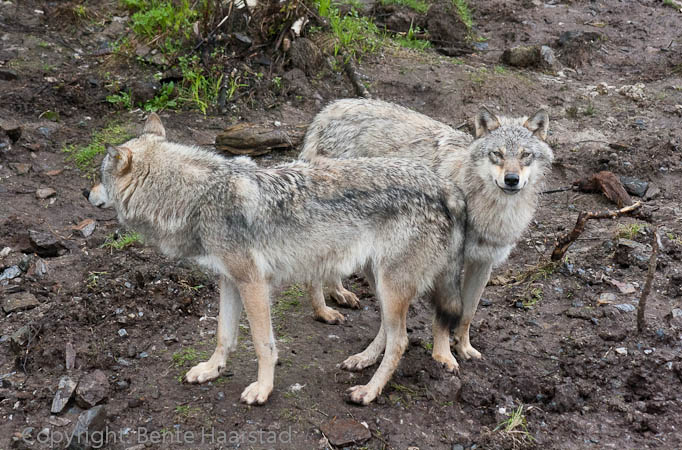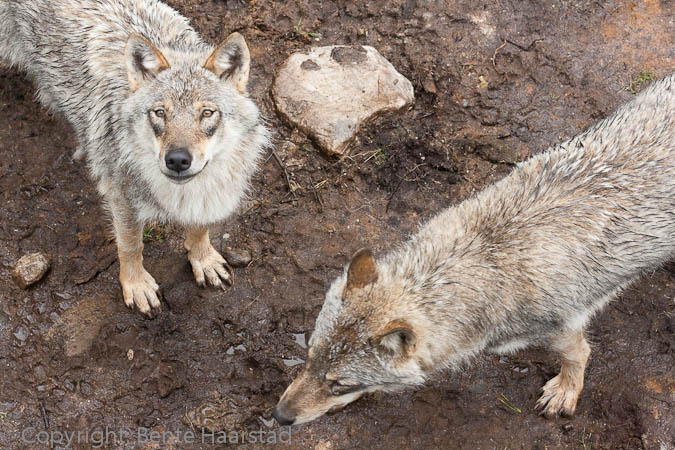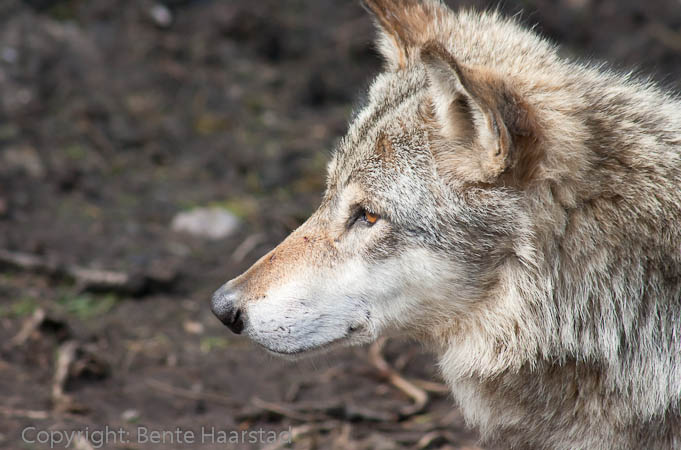The Scandinavian wolf was more or less extinct, but the last 20-30 years there has been considerable effort to reintroduce and/or strengthen the population. And so far this winter nature management have tracked 52 to 56 wolves in Norway. Half of these are so far only registered in Norway, while the other half, ie 26 to 28 wolves, are located in the border territory to Sweden. That means they come and go across the border.
In Norway the population of wolf was more or less extinct around 1860, according to scientific statistics, and in the years since it was only occasional transient individuals. The wolf was listed as a protected species in Sweden in 1965, and in Norway in 1973. But genetic analyzes indicate that the Scandinavian wolf was extinct, and that it was immigrants from the east, from Russia and Finland, and their descendants, who eventually got the benefit of wolf protection. The joint Norwegian, Swedish and Finnish populations in the mid-1970s, was probably not exceeding ten animals.
From 1966 untill 1980 there were no wolf shot in Norway, according to Statistics Norway that have such figures back to 1846 for all the big predators. Suddenly there were wolf again, but not many. Genetic studies show that the current Scandinavian tribe originates from a single pair of wolves with Eastern origin, but that another male came in 1990-91, according to facts from the swedish authorities. Here are maps that shows todays distribution of wolves in Europe and Norway.
The wolf is a a controversial animal in both Sweden and Norway, because it can kill livestock and reindeers, dogs and for certain a lot of moose, deer and roedeers. You can almost say that people who live in the towns and cities loves the wolf and wants more of them, while many people in the countryside see the wolf as a problem, as do many hunters and dogowners who live in wolf-land. That is especially the southern parts of both countries.
There are more wolves in Sweden than in Norway, but all together there are not enough fresh blood to keep the population viable says the scientists. The swedish government have decided to to use new and many says drastic methods to enhance the genetic strain in the wolves. That is releasing wolf puppies from the zoo to wild adoptive mothers, and to translocate wild wolves from Finland and maybe Russia. The places to release the new wolves is supposed to be announced before the end of March this year. But there are a lot of protests, and at least one swedish zoo have declined to deliver wolf puppies during the last days. And a new law might make the landowners to decline any new wolves, and that might stop the whole projects, writes the newspaper DN.se.
The wolf is a critically endangered species in Norway and Sweden. Around the world there are an estimated 200,000 in 57 countries, compared to up to 2 million in earlier times, according to the organization Defenders of Wildlife.
These images are all photographed in a norwegian zoo, Namsskogan Familiepark. It is a typically norwegian zoo with almost only nordic species, and big enclosures that gives the animals some space. I have some more photos from the wolves and other animals in this zoo in my web gallery.








Wow ! Just beautiful – I LOVE wolves. I find them absolutely fascinating and their family dynamics are truly special. Thanks for sharing this, and let’s hope that the wolves find some support.
LikeLiked by 1 person
What a wonderfully informative posting! I also teach Environmental History and we spend quite a bit of time talking about Aldo Leopold’s Land Ethic (http://www.aldoleopold.org/) and the importance of predators for the health of an ecological system. These are beautiful photographs and, I hope you don’t mind, I would like to share this with my classes here in Nebraska!
Thanks for the post!
LikeLiked by 1 person
Hi,
This is great news, lets hope they keep on growing in numbers.
Great photos.
LikeLike
Great post Bente! Such beautiful animals. Public awareness, which comes from many sources, including articles such as this one, is an important step towards assuring that this current population of wolves continues to rebound. Thanks for being part of their future success.
LikeLiked by 1 person
Stunning photos! They look so much like the Coyote of the American Southwest. I’m in Oregon now and we see Coyotes here, but I remember them best when I lived in Arizona as a child. Brings back memories, thanks.
LikeLiked by 1 person
Here, it is coyotes that are disliked and viewed as a threat. I live in the country and it just wouldn’t be the same without their haunting, eerie cries. It’s one of my favorite sounds in the world. I’m on the side of the wolves!
LikeLike
It must be noted here, that Sweden is divided in two parts, Wolf Lovers nd Wolf Haters. The Haters are mostly rural people , caring for their livestock plus the Sami people, that want to protect their Reindeers,
The bordergoes so: Rulal people don’t want the wolves on their territory and City people want wolves.
I knew cases where wolves have been killed illegally, up in Härjedalen, bordring to Norway.
It’s an extremely sensitive issue this with wolves.
LikeLiked by 1 person
The Gray Wolf has been re-introduced here too and it has been doing very well. There are many wolf-haters here too, unfortunately. What I don’t understand is that most of the haters have never seen a wolf and really have nothing at all to do with them. I wonder of some left-over primordial fear has anything to do with it. I hike hundreds of miles each year in Montana’s wild country and I see tracks occasionally, but wolves have by no means taken over the wilderness, and the other wildlife numbers are still good.
LikeLiked by 1 person
The wolf issue has divided Sweden in two parts. First of all. most rural and Sami people want ni more wolves or zeri wolves at all.
Frankly, it mostly city people that support wolves.The illegal hunt of wolves is huge. There are death threats and so on to people that are engage in the issue.
I know people in Härjedalen, a community , bordering to Norway.
The hunters said, here we follow our own ruls and kill wolves. We just don’t want them here!!! That’s people reactions, but they seem to have forgoytten the good things wolves do in the ecosystem, leaving carcasses to smaller predators etc.
LikeLike
I guess you overexceggerate, most of the population is somewhere in between far from the extreme ends, but the extremists are loud. Even the largest hunting organisation accepts wolves but think they are too many now. Illegal hunting has decreased and is the last five years suspected to be a major cause of death (only one case with recovered body was found 2010-2011), but is now raising. There are very few wolves in reindeer country, the northern half of Sweden, where Härjedalen and reindeer owning sami are. Reindeers are not fenced and thus very vulnerable to wolf attack. But there are only 4000 reindeer owners and only for 400 it is the major income, so peoplewise they are very few. These Sami claim that they have big respect for the wolf, they just do not want it where the reindeers are. But they have the right to manage (almost) half of Sweden for reindeers. The people who in some way are near the disadvantages of the wolves are very very hard to convince the good things wolves do, like leaving carcassess to small predators, which by the way hunters also do (some remains after butchering a much larger number of animals, but much lower proportion left of course and not equally distributed over time) and some of those utilizing the carcasses may constitute problems themself. Almost all hunters think human consumption would be a better use for most of the carcasses, now they have to be replaced by Brazilian beef cows.
LikeLike
Wao ! You got quite a collection of impressive photos.
When I arrived Europe (35 years ago), I traveled all around.
And went up mountain from Trondheim, crossing the border (somewhere 🙂 )
then came down to somewhere Swedish village.
It was a nice walk and thanks goodness I didn’t meet a wolf. 😀
LikeLike
Well it seems you have been around my district! 😉 I usually do not meet any wolf either. Most of them are much further south, closer to Oslo than here.. 😉
LikeLiked by 1 person
A great set of photos of a beautiful species. I’m glad you told us that the photos were “all photographed in a norwegian zoo.” Otherwise, you were running with (and risking getting eaten by) the pack.
LikeLike
Thanks! 😉
LikeLike
THANKS for returning my visit and leaving a “like.”
LikeLike
I just the movie THE GREY starring Liam Neeson where wolves there will make you angry for their ravaging behavior. This post made me see the other side of coin: they’re lovable and fun to look at — the first photo in particular. It’s just saddening to know that they’re already critically endangered.
LikeLike
The world population is not critically endengered, but the wolf is given this status in Norway and Sweden.
LikeLike
Thanks for pointing that out. Yeah, at least in the two countries then.
LikeLike
In many tales and legends, the wolf was an enemy to fight.
Pleased that this majestic animal is now respected.
(excuse me, I no longer practice English for my studies, and I use the google translator ! 😳 )
LikeLike
I had wondered how you got so close to these beautiful creatures! Wolves are gaining respect from the general populace here in the states too, but the locals who have to live side by side, so to speak, are not so thrilled. Too bad for the wild creatures and for the diversity of animals the world wide. If you choose to live amongst them, then you must learn to compromise and respect their nature.
Your photographs are amazing (site wide)! Thanks for visiting me today and for liking my vignette.
~ Lynda
LikeLiked by 1 person
Very interesting developments. There was some debate a few years ago about the possibility of reintroducing wolves into Scotland.
LikeLike
Thank you for liking my site here in the USA. Your article on wolves is very interesting, as here in Central Virginia, we have many sitings of coyote and they are often killed. This planet must find a way to live with wild creatures, including predators. We humans cannot invade wild habitat and expect to dominate. Thank you for your informative blog and fascinating photographs.
LikeLiked by 1 person
Nice informative piece! I love wolves, they are the perfect medium between majestic and ferocious to me (a city girl, I have to admit :D).
Thanks for liking my posts too!
LikeLike
😉
LikeLike
Wolves are one of my favorite animals 🙂 I saw two wolves when I went to Vancouver, Canada. They are beautiful animals!
LikeLike
Bente, thanks for the “like”, this is a great post with excellent images, zoo shots a fine as long as we know. It is sad that there are so many that hate and fear wolves, they are beautiful, sentient beings that should be allowed to exist. Here in the US the story is the same, maybe someday we will evolve.
LikeLike
Thank you for a nice show. I think it is more correct to regard “Scandinavian wolf” endangered (EN) than acutely endangered since its fast recovery.
There might be 350 now. No population controlling “quota hunt” in Sweden 2012, because EU threatended to accuse Sweden to the EU court and Sweden wants to please EU. The number is fastly growing, 25% annually or so. The government has not indicated the limit at which growth will be brought to an end or even if such a ceiling will be made. The Swedish wolf management was a success story till EU interferred, but now I think the acceptance is dwindling.
The presence of wolf has support of a clear majority of the people and the parliament, but you may doubt that there is a public support for the current raise and lack of control and already current numbers are not supported by many of those living close to the wolves (in many places a majority against).
I am a geneticist and for reducing the inbreeding of Scandinavian wolf I argue we have too many (the new blood will be too diluted) and ought to do selective hunting (reducing the inbred). Without those tools to boost the effect of adding unrelated wolves and utilizing the limited immigration, the reduction of inbreeding will be very slow.
I write about this (in Swedish) on my blog http://vargdag.wordpress.com/
LikeLike
Nice pictures
LikeLike
Wolfs can be a problem.We must find the just way Not to much and healthy animals.Great photo’s Bente
LikeLike
Wonderful shots, Bente!
LikeLike